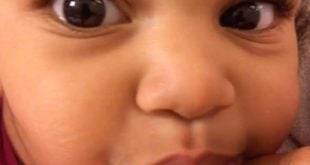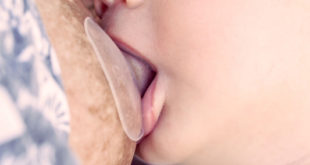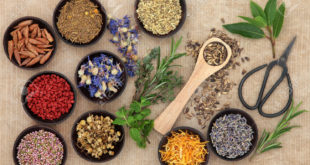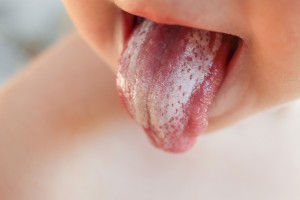 Candida (also called yeast, or thrush) is a fungus that occurs naturally in the mucous membranes and on the skin. Use of antibiotics promotes the overgrowth of yeast by killing off the ‘good’ bacteria that normally keep the yeast from multiplying too quickly. During pregnancy, yeast infections are more common because high levels of estrogen lead to elevated levels of sugar, and yeast feeds on sugar.
Candida (also called yeast, or thrush) is a fungus that occurs naturally in the mucous membranes and on the skin. Use of antibiotics promotes the overgrowth of yeast by killing off the ‘good’ bacteria that normally keep the yeast from multiplying too quickly. During pregnancy, yeast infections are more common because high levels of estrogen lead to elevated levels of sugar, and yeast feeds on sugar.
If you or your baby have recently been on antibiotics, if you have had a vaginal yeast infection during the last several months (or anytime during pregnancy), or if your nipples are cracked, then you and your baby are at risk for developing a yeast infection. Other factors that make you more susceptible to yeast include use of steroids or hormonal contraceptives, or chronic illness such as diabetes or anemia.
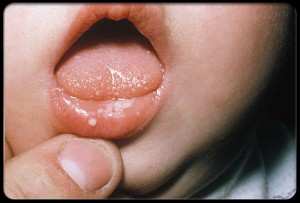 Symptoms of a yeast infection in your baby include creamy white spots or patches on the mucous membranes inside the mouth (gums, cheeks, or tongue). The spots may look pearly, and may be surrounded by redness. If you gently scrape the spot, it may be reddish underneath (unlike a coating of milk on the tongue). Sometimes the inside of the lips or the saliva may have a ‘mother of pearl’ appearance. The baby may be fussy and gassy, and sucking may be uncomfortable for him. He may pull off the breast, or may refuse to nurse at all. It is also possible for him to have an overgrowth of yeast but have no visible symptoms.
Symptoms of a yeast infection in your baby include creamy white spots or patches on the mucous membranes inside the mouth (gums, cheeks, or tongue). The spots may look pearly, and may be surrounded by redness. If you gently scrape the spot, it may be reddish underneath (unlike a coating of milk on the tongue). Sometimes the inside of the lips or the saliva may have a ‘mother of pearl’ appearance. The baby may be fussy and gassy, and sucking may be uncomfortable for him. He may pull off the breast, or may refuse to nurse at all. It is also possible for him to have an overgrowth of yeast but have no visible symptoms.
Yeast can also cause a rash in the baby’s diaper area. The rash is red or bright pink, and may be scaly. The affected area may contain small raised red spots or sore looking pustules. The rash may be localized (the area looks like it has been dipped in scalding water) or it may be diffuse and lacy, covering a large area. Use of standard diaper rash medications like petroleum jelly or Desitin does not clear up a rash caused by yeast, and may actually make it worse, because yeast feeds on the oils found in greasy ointments, and also on the starch found in baby powders.
Symptoms in the mother include severe stinging, burning pain, which may be on the surface of the nipples, or may be felt deep inside the breast. Pain often continues throughout the feeding and in between feedings – especially immediately after. (Nipple pain caused by incorrect positioning and latch on rarely hurts except when the baby is nursing). Sometimes sharp, shooting pain radiates from the nipple into the breast or into the back or arm. Nipples are sensitive to light touch, so it may hurt to have clothes rubbing against them, and it may be very painful to take a shower and have the hot water spray touch the breast. Mothers describe the pain as ‘liquid fire’, ‘hot needles’, ‘razor blades’, ‘a piece of glass stuck in my nipple’, etc. I’ve heard many mothers say that they would rather go through labor again than have yeast on their nipples or in their milk ducts, which gives you an idea of just how painful this condition is.
The nipples may look puffy, scaly, flaky, weepy, or have tiny blisters. They may be itchy. The color is often a deep pink. The nipples may also look completely normal, but be terribly painful (just as the baby’s mouth may be infected, but not have white patches). Generally, the nipples don’t “look as bad as they feel’, so there is often a tendency to underestimate the severity of the problem based simply on visual examination of the nipples. If you have yeast on your nipples, or if your baby has it in his mouth, your milk supply will often decrease. Pain inhibits the let-down reflex, and babies with yeast often do not nurse as efficiently as they do when their mouths are not sore. Yeast infections may also lead to plugged ducts and mastitis.
Once the infection is cleared up, you should be able to build your supply up again quickly. It is important to note that while yeast on baby’s bottoms or in their mouths may be tender and irritated, it does not seem to cause extreme pain like it does on the mother’s nipples or in her milk ducts.
Mothers may also have a vaginal yeast infection (itching, cottage cheesy discharge), sores at the corners of the mouth (angular chelitis), swelling or tenderness of the tissue around the toes or fingernails (candida paronychia), or a rash in the moist areas of the body such as under the arms or in the groin (intertriginous candiasis). Athlete’s foot is also a type of fungal infection.
Because yeast grows in warm, moist areas, it can be traded back and forth between a mother and her nursing baby. Both mother and baby must be treated together in order to clear up the infection. It is important to do this even if one of you does not have symptoms. For example, your baby may have the white patches in his mouth, but your nipples may not be sore – or, your nipples may be sore but your baby’s mouth and diaper area may be clear. If you treat one of you and not the other, you may clear up the infection in one place only to have it reoccur a week or two later in another. Occasionally, other family members (especially your sexual partner) may need to be treated at the same time. Consult your doctor regarding a treatment plan.
The diagnosis of yeast is most often made based on the symptoms, and not on a definitive culture. It is sometimes possible to culture for yeast from the surface of the nipple, or from the milk, but the tests are not reliable and most often give a false negative result.
If you or your baby have any of the symptoms described above, (especially if you have been on antibiotics, or if your nipples suddenly become sore after the first two weeks postpartum), you may have a yeast infection. If you believe you may have a yeast infection, here are some suggestions on how to treat it (always consult your health care provider before beginning any treatment). It is important to begin treatment only after ruling out other possible causes of severe nipple soreness, such as improper latch on and positioning, mastitis, eczema, herpes, ringworm, and psoriasis.
If you have yeast on your nipples:
- Wash hands often (before and after nursing, after using the bathroom, and before or after changing the baby’s diaper). Use hot, soapy water and paper towels.
- Nurse frequently for shorter amounts of time. Start nursing on the least sore side. Numb the nipple with ice wrapped in a washcloth before beginning to nurse. Take Advil (unless you are allergic to it) around the clock. If it becomes too painful to nurse, you may want to pump your milk temporarily and feed it to your baby by cup or bottle until the pain lessens.
- Try drinking green tea 3 or 4 times a day. It may help cleanse your system of excess yeast, and all evidence points to its benefits, so it certainly won’t hurt to try.
- Eating yogurt, while helpful, is not enough to treat a yeast infection by itself. Another supplement that is often helpful is Caprylic acid. The usual dose is 1-2 capsules with each meal. These products can be found at most health food stores. Working with a herbal specialist to adjust the dosages may be helpful.
- After nursing, rinse the nipples with a solution of one cup of water plus one TBSP of vinegar. Air dry well. Apply antifungal creams like Lotramin AF or Gyne-Lotramin (containing clotrimazole) or Monistat (containing miconazole). These are available without a prescription. Your doctor may also prescribe an antifungal cream like Nizoral (containing ketoconazole). Although Nystatin has been the most popular prescription antifungal used for many years, it is no longer the first choice of treatment due to resistant strains of yeast that have developed.
- If pain is severe, apply the cream sparingly after each feeding (6-8 times per day) for 24 hours. Then apply 3-4 times daily. The cream is absorbed quickly, and does not have to be removed before baby nurses. If you feel that some ointment remains on your nipple, you may want to gently press a damp warm washcloth on the nipple and areola before nursing. Avoid wearing nursing pads, but if you have to use them be sure to change them at every feeding. Keep the nipples as dry as possible.
- Decrease consumption of foods containing high amounts of sugar and/or yeast (such as beer, wine, sodas, bread, desserts, etc.).
- Dietary supplements that may be helpful include: Lactobacillus acidophilus (probiotic) helps promote the growth of ‘friendly bacteria’). The usual dose is 1/4 to ½ tsp. of powder or 1-2 capsules, 1-4 times daily. Bifadophillus also works well, and does not contain apple pectin, which may limit the supplement’s effectiveness. Acidophilus supplements of up to 24 tablets a day are not harmful, and may be helpful in severe or chronic cases.
- For information about the use of coconut oil and other alternative treatments for yeast, see Natural Remedies for Yeast Infections.
After 24-48 hours, you should feel some improvement. (Sometimes you can tell a difference after just one application. In some cases, symptoms may temporarily get worse before they get better – so be sure to continue the treatment for at least the full 48 hours. If you don’t see improvement by then, try a different antifungal cream. Just as certain antibiotics are effective against certain strains of bacteria, certain antifungal creams are effective against certain strains of yeast. Without culturing the yeast (which is very difficult to do) you don’t know exactly which strain you have, so if one medication doesn’t work, try another.
Another effective anti-fungal treatment that is inexpensive and available without a prescription is gentian violet. It can be used on your nipples and in the baby’s mouth or diaper area. Be sure to consult your health care provider before beginning treatment, because it is strong medicine and be dangerous if used improperly or too long. It is very messy (it looks like purple ink and stains anything it touches, including baby’s mouth and lips, and clothing or bedding). It usually comes in a one percent solution, which you may want to dilute down to a ½ percent solution, especially if using it in the baby’s mouth. Apply to nipples, baby’s mouth or diaper area once or twice daily for no more than 3 days. You may continue to use a topical ointment at the same time. Apply with a cotton swab, especially at bedtime when the baby is more likely to sleep for a longer stretch without nursing. Wear old clothing, since it does stain. If you get stains on clothing, try alcohol, bleach, or aerosol hairspray to remove them. Stains on the skin will usually fade in a few days. Applying a thin coating of lanolin to the baby’s lips may minimize staining on his face when gentian violet is applied to his mouth or your nipples.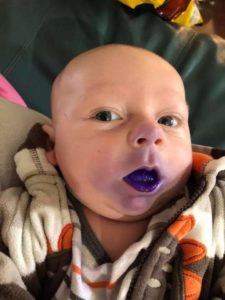
Expressed milk should be fed to the baby while you are both being treated for yeast, and not saved for later use, since refrigerating and freezing the milk may not kill all the yeast.
For a vaginal yeast infection, ask your doctor which medication he suggests. Non-prescription medications like Gyne-Lotramin and Monistat 7 are often effective, or your doctor may prescribe a medication like Terazol 7 (tercoconazole). Rinsing the vaginal area with a vinegar and water solution after using the toilet may be helpful. Expose the affected area to air as much as possible by wearing cotton (or no) panties and avoiding tight clothes like pantyhose and swimsuits. A single dose of Diflucan oral medication (fluconazole) is also often used to treat vaginal yeast infections. It is available by prescription.
For yeast in the baby’s diaper area, ask your doctor which medication he suggests. Often the same antifungal ointment used on your nipples, whether prescription or over the counter, can be effective in clearing up the baby’s bottom. If the area is extremely inflamed, ask your doctor about an ointment containing cortisone (such as Mycolog or Lotrisone). If the rash does not seem to be responding to antifungal cream within a few days, ask your doctor about using a ½ percent solution of gentian violet in addition to the cream once or twice a day for a few days.
After each diaper change, wash the baby’s bottom with warm soapy water. Rinse and dry well. Avoid using commercial baby wipes (they keep the skin moist, and may contain irritating chemicals). Expose the baby’s bottom to air as much as possible.
For yeast (thrush) in the baby’s mouth, your doctor will probably prescribe oral nystatin drops. After each nursing session (or however often your doctor suggests) rinse the baby’s mouth with water, offer him a drink of water from a cup, or wipe the inside of his mouth with a damp washcloth. Milk that remains in the baby’s mouth can be a source of food for yeast. Then apply the medication according to directions. Usually, the directions say to use 2cc in each cheek four times a day. Since yeast multiplies so quickly (as often as every hour), you may want to ask the doctor if you can use 1cc for the whole mouth 8 times a day. Put the medicine in a spoon or paper cup and use a Q-tip to swab it in the baby’s mouth. Don’t put the dropper directly in his mouth and then back in the bottle, to avoid contaminating the medication. Once there are no visible signs of yeast in his mouth, ask your doctor about cutting back to a lower dose. A complete course of treatment usually takes several weeks. If there is no improvement in a few days, ask your doctor about using a ½ percent solution of gentian violet for a few days.
Boil any object that goes in the baby’s mouth (such as pump parts, bottles, toys, and pacifiers) for 20 minutes each day. Add some vinegar to the boiling water. Continue using the medication for at least 2 weeks after symptoms are gone. If nystatin and gentian violet do not seem to be clearing up the thrush in the baby’s mouth, ask your doctor about pediatric Diflucan suspension. As of November 1995, it has been approved for pediatric use in treating babies six months or older, and has an FDA Safety Profile for newborns one day and older. The clinical cure rate for oropharyngeal candidiasis in pediatric patients is reported at 86-100% with Diflucan (2-3 mg/kg/day) as opposed to 32-46% of patients treated with nystatin.
In certain cases, yeast infection on the mother’s nipples does not respond to topical treatments. In these cases, pain is severe and unrelieved. Pain may begin as burning or stinging on the surface of the nipples, primarily during breastfeeding, and progress to deep stabbing internal pain inside the milk ducts. This type of deep, sharp pain continues throughout the day and may be worse at night, interfering with the mother’s sleep. Pain may radiate into the armpit or back. If topical treatments are ineffective, you may need to talk to your doctor about the possibility of using a systemic treatment which is taken orally, and is available only by prescription. You may want to ask him to prescribe a prescription painkiller as well.
The systemic treatment which seems to be most effective is Diflucan (fluconazole). Discuss the following treatment plan with your doctor, as this is strong medication and should be used only when topical treatment has failed to prove effective, or when the yeast has spread into the milk ducts.
Diflucan is often used to treat vaginal yeast. For treatment of a vaginal yeast infection, 150 mg in a single dose is the current FDA recommendation. Unfortunately, this therapy is not sufficient for ductal candidiasis in lactating women. For the treatment of systemic (ductal) yeast, 400 mg STAT (loading dose on the first day) followed by 150-200 mg daily for periods of up to four weeks is generally recommended by many clinicians.
Of antifungal medications, Diflucan is well tolerated. Adverse effects (such as vomiting, diarrhea, stomach cramps, and rashes) have only been reported in 5-30% of patients, and only 1-2% of patients had side effects severe enough to require them to discontinue the medication. In rare cases, adverse hepatic (liver) effects have been reported, but usually in connection with high doses of the medicine over long periods of time in severely ill patients with immune-compromising diseases such as cancer or AIDS. I don’t know of any cases of liver problems in healthy nursing mothers at the doses recommended in this article.
Be persistent in treating yeast. Once you have it, it tends to stick around and not go away by it self, because it thrives on moisture and sugar, and nipples and baby’s mouths provide the perfect environment for it to grow. Some women seem to be more prone to developing yeast infections than others. Yeast infections during lactation can be very painful, and it is easy to become discouraged and even consider weaning your baby. Try to remember that yeast is a medical condition that, with consistent treatment of both mother and baby, can be cleared up completely, and hopefully will not reoccur. It is also important to note that if you have yeast on your nipples or in your milk ducts, weaning your baby will not necessarily make it go away and you will still need to treat the problem.
Be sure to remain in close contact with your health care provider during treatment, because yeast presents a variety of symptoms an requires continuing reassessment and adjustment of treatments to provide optimal pain relief and effect a cure in the shortest period of time. Try not to become discouraged. Yeast is wicked stuff, but this too shall pass.
Anne Smith, IBCLC
Breastfeeding Basics
Resources:
Thrush FAQ, La Leche League International
Comparison of fluconazole and nystatin oral suspensions for treatment of oral candidiasis in infants. By R.A. Goins, D. Ascher, N. Waecker, J. Arnold, E. Moorefield; Pediatric Infectious Disease Journal 2002
History, physical and laboratory findings, and clinical outcomes of lactating women treated with antibiotics for chronic breast and/or nipple pain: Eglash A, Plane MB, Mundt M.J Hum Lact.2006.22(4):429-33. [Abstract]
Natural Remedies for Yeast Infections; Anne Smith, IBCLC, Breastfeeding Basics, 2018
Diagnostic value of signs and symptoms of mammary candidosis among lactating women:Francis-Morrill, J. Heinig JM, Pappagianis D, Dewey KG.J Hum Lact. 2004;20(3):288-95. [Abstract]
Candida Protocol, https://www.breastfeedinginc.ca/informations/candida-protocol/ Dr. Jack Newman, Breastfeeding Inc., 2009
Breastfeeding and Human Lactation 5th Edition; Karen Wambach, Jan Riordan, London: Jones and Bartlett Publishers; 2015
Medications and Mother’s Milk, Dr. Thomas Hale, 17th Edition, 2017
Counseling the Nursing Mother, Judith Lauwers and Anna Swisher; Jones & Bartlett Pub; 5th edition; January 15, 2010
Breastfeeding: A Guide for the Medical Profession, 6th Edition: Ruth A. Lawrence MD, March 2015
In vitro antimicrobial properties of coconut oil on Candida; Ogbolu DO, Oni AA, Daini OA, Oloko AP. J Med Food. 2007 Jun;10(2):384-7:
Fluconazole Concentrations in Breast milk; Force, RW.; Pediatric Infectious Disease 14 (3): 325-336, 1995
Candidiasis and Breastfeeding (Unit 18); Amir L, Hoover KL, Mulford CA: Lactation Consultant Series. New York: Avery Publishing Group, Inc. 1995
(Edited September, 2018)
If you or your baby have recently been on antibiotics, if you have had a vaginal yeast infection during the last several months (or anytime during pregnancy), or if your nipples are cracked, then you and your baby are at risk for developing a yeast infection.
 Breastfeeding Basics
Breastfeeding Basics

